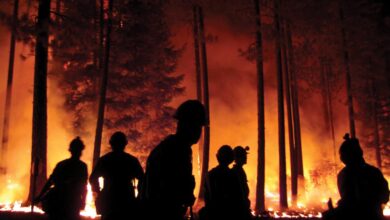36 Organizations Helping Solve the Climate Crisis – Food Tank

Contributing author: Allison Reser
Climate change continues to increase the rate of extreme weather events, disrupt ecosystems, and cause sea levels to rise, according to the National Oceanic and Atmospheric Administration.
The Intergovernmental Panel on Climate Change (IPCC) AR6 Synthesis Report finds that global greenhouse gas (GHG) emissions are likely to exceed 1.5ºC during the 21st century, making it harder to limit warming below 2ºC.
The United Nations deems climate change the defining crisis of our times, and according to the Yale Program on Climate Change Communication, 64 percent of adults in the United States say they are at least “somewhat worried” about the climate crisis.
“Whatever scale, people want to address this, they want to do something, they want to feel empowered, they want to feel effective, and the best way to do that is to get together and share what everyone knows,” environmental activist and founder of Project Drawdown Paul Hawken tells Food Tank.
Fortunately, there are hundreds of organizations around the globe who are working collaboratively and inclusively to find solutions. By engaging eaters, community activists, policymakers, artists, families, and more, they are helping people step up and, hopefully, save the planet. Food Tank is excited to highlight a snapshot of exciting organizations working to solve the climate crisis.
1. 350.org, International
Author and activist Bill McKibben and a group of university friends founded 350.org in 2008, with the goal to keep the global carbon dioxide concentration under 350 parts per million. They are using the power of collective individuals internationally to stop oil and gas development and move to 100 percent renewable energy.
2. Arab Forum for Environment and Development (AFED), Arab Region
AFED’s mission is to promote environmental education and provide space for environmentalists to come together. They advocate for sustainable development, and influence planners, decision makers, businessmen, civil society, and media. AFED hosts an annual Health and the Environment in Arab Countries Conference and also publishes the AL-BIA WAL-TANMIA (Environment & Development) magazine.
3. Asia Pacific Adaptation Network (APAN), Asia and Pacific Region
To build more resilience against the consequences of climate change, APAN supports adaptation across Asia and the Pacific Region. APAN provides resources and tools for planning, financing, and building adaptive societies. For example, there are publications on Coastal Zone Management that can help coastal communities reduce damage from sea-level rise.
4. Biomimicry Institute, International
Biomimicry is a design technique that solves problems by mimicking nature. Biomimicry Institute’s mission is to promote the transfer of ideas, designs, and strategies from biology to sustainable human systems design. For example, someone who wants to spend less energy building might consider using Moist Brick, a naturally cooling building material that can condense water from nighttime air similar to the skin of a Texas Horned Lizard.
5. C40 Cities, International
C40 brings together a network of megacities from around the world, allowing them to drive climate action through collaboration and knowledge sharing. New York City, Johannesburg, Hong Kong, Sydney, Tokyo, London, and Mexico City are just some of the cities on the list that have committed to the climate targets established in the Paris Agreement.
6. Caribbean Community Climate Change Center (CCCCC), Caribbean Region
The CCCCC works to coordinate the Caribbean region’s response to climate change by identifying solutions. The Centre offers several tools and resources to help users take appropriate action in their communities. They also carry out a number of projects to address issues caused by climate change across the Caribbean region.
7. Citizens’ Climate Lobby, International
As a 501(c)4 nonprofit organization, Citizens’ Climate Lobby pushes for nonpartisan policies to address climate change. With over 600 local chapters internationally, Citizens’ Climate Lobby builds political support for climate action by empowering individuals to use their own voice. They provide people with a toolkit to help with outreach, engagement, organizing, media, and lobbying.
8. Climate Alliance, International
Made up of municipalities and districts, regional governments, nongovernmental organizations (NGOs), and other organizations, Climate Alliance is one of the largest European city networks dedicated to climate action. The Alliance promotes actions to slow climate change in both European municipalities and the Amazon River basin.
9. Climate Action Network (CAN), International
CAN is a global network of more than 1,300 environmental NGOs. With regional hubs in regions including West Africa, South Asia, Latin America, and Eastern Europe, the Network works to promote governmental and individual action to address the impacts of climate change. CAN’s working groups address a variety of issues including agriculture, science policy, and technology.
10. Climate Cardinals, International
With the belief that every person has the right to basic environmental education, Climate Cardinals’ mission is to translate climate information into the native language of those who don’t speak English. With the help of over 6,000 volunteers, this youth-led organization has worked in over 40 countries globally and helped 350,000 people understand climate change.
11. Climate Collaborative, United States
Focused on natural foods businesses concerned about climate change, the Climate Collaborative breaks climate action down into three simple steps: commit, act, impact. To date, 673 businesses have made commitments, and the Climate Collaborative offers a variety of resources and support to these businesses to help them reach their goals.
12. Climate Group, International
The Climate Group is working toward net-zero emissions by 2050 by holding organizations accountable for climate commitments they make. International business and government leaders come together to make commitments during Climate Week NYC. Then, Climate Group holds them accountable by sharing the actions they’ve taken and connecting them to other groups with similar objectives.
13. Climate Justice Alliance (CJA), United States
CJA brings together frontline, community-based organizations to lead the just transition from an extractive economy to a regenerative one. The 70 member communities are small grassroots organizations working locally to fight climate change with traditional ecological knowledge. CJA unites these members with each other to scale up their impact nationally.
14. Earthjustice, United States
Earthjustice uses the power of the law to protect communities’ and the planet’s health. With offices across the U.S., their work has helped to save wildlands, halt destructive logging and mining, and encourage more sustainable farming policies. Their sustainable food and farming program works to improve worker safety, promote climate-friendly farming practices, and reduce pollution by factory farms.
15. Environmental Defense Fund (EDF), United States
For over 50 years, EDF has brought together scientists and lawyers to protect the environment. Using strategic partnerships, scientific and economic research, and advocacy, EDF works to strengthen laws and policies that improve the environment and public health. To do so, EDF takes on a wide variety of cases that range from overfishing and food contaminants to pollution from the oil and gas industry.
16. Environmental Working Group (EWG), United States
EWG researches how consumer products impact human health and the environment. A wide range of experts at the EWG makes it easier for consumers to understand the environmental impact of the products they purchase. EWG also annually releases the “Clean Fifteen” and “Dirty Dozen,” which list the produce with the least and most pesticide contamination respectively.
17. Extinction Rebellion (XR), International
XR is a nonpartisan movement that demands governments declare a climate emergency, reach net zero emissions by 2025, and involve citizens in decision making. They use non-violent direct action and civil disobedience to communicate the urgency of the climate crisis. Because of the decentralized leadership, anyone from anywhere in the world can organize XR actions as long as it abides by core principles and values.
18. Fridays for Future (FFF), International
Started in 2018, FFF is a global climate strike movement that demands urgent action from government leaders. They work to put pressure on policymakers to listen to scientific experts about the consequences of climate change, ensure climate justice, and keep the global temperature rise below 1.5 degrees C compared to pre-industrial levels. FFF also offers a number of online resources for those interested in getting involved with the movement.
19. Friends of the Earth, International
Friends of the Earth uses the collective voice of grassroots members to speak truth to power and advocate for living in harmony with nature. They’ve caught the attention of large corporations and government agencies worldwide to demand that the rules of our political and economic systems need to change if we are to combat the climate crisis.
20. Gender CC, International
Created as a result of the United Nations climate negotiations (UNFCCC), GenderCC acknowledges that women play an important role in fighting climate change. This global network of organizations, experts, and activists are working to integrate gender justice into climate justice through raising awareness and empowering women.
21. Greenpeace, International
Founded in 1971, Greenpeace is a global organization that uses peaceful protest and strategic communication to highlight environmental issues and promote solutions. Now in more than 50 countries, Greenpeace works to halt deforestation, protect ocean health, stop nuclear testing, and more. Through solutions rooted in social justice, they hope to help communities disproportionately impacted by climate change.
22. Health and Environment Alliance (HEAL), Europe
HEAL works to shape laws and policies that protect planetary and human health and raise awareness about the benefits of mitigating climate change. Their goal is to create a toxic-free, decarbonized, and climate-resilient future. With over 90 member organizations, HEAL represents 200 million people across the 53 countries in the European region.
23. Indigenous Environmental Network (IEN), International
As part of the Native environmental justice movement, IEN formed in the U.S. after tribal grassroots youth and Indigenous leaders gathered to discuss the environmental assaults on lands, waters, communities, and villages. Today it connects Indigenous communities nationally and globally to protect sacred sites and natural resources, and support a just transition, carbon pricing, and the Green New Deal.
24. Julie’s Bicycle, International
Julie’s Bicycle supports the global Creative Climate Movement, helping artists use their creativity to become climate activists. In addition to contributing to low-carbon creative programs, initiatives, campaigns, and communications, Julie’s Bicycle developed The Creative Industry Green Tools, a set of free online carbon calculators. These calculators allow creative productions to measure their environmental impact, such as energy use and waste.
25. La Via Campesina, International
A grassroots network of more than 180 international organizations and 200 million farmers, La Via Campesina, fights for food sovereignty and better management of the world’s resources. The group promotes agroecological farming techniques that work with the earth and help to mitigate climate change.
26. Natural Resources Defense Council (NRDC), International
With simple online actions anyone can take, plus three million members, and an international staff of experts, NRDC safeguards people, plants, animals, and natural systems. By making strong partnerships across the United States, Canada, China, India, and Latin America, NRDC is pushing for climate solutions like solar power, electric vehicles, and national limits on carbon emissions.
27. Naturefriends International (NFI), International
Founded in 1895, NFI is one of the largest NGOs in the world. With 350,000 active members, NFI advocates for environmentally and socially just tourism, and protects natural and cultural heritage sites. They provide activities and materials for experiencing nature and climate justice, such as an informative quiz about sustainable tourism.
28. Oceanic Global, International
Oceans store carbon and are integral in the fight against climate change. That is why Oceanic Global combines grassroots initiatives with industry solutions to shed light on humanity’s essential relationship to the ocean. Through regional hubs in New York, Hamptons, Los Angeles, London, and Barcelona, Oceanic Global offers educational programming and community partnerships. The Oceanic Standard is their tool to help industries find sustainable vendors and improve their operations to keep the ocean healthy.
29. Our Kids’ Climate, International
Originally founded in Sweden, Our Kids’ Climate is a global network of parents who want to protect their kids from the climate crisis. Any group of parents from around the world can join the network to participate in family art projects and speak to mentors.
30. Project Drawdown, International
“Drawdown” refers to the point at which greenhouse gas emissions start to decline. Project Drawdown is an open-source and expert-reviewed resource that policymakers, universities, corporations, and activists around the world can turn to for climate solutions. For example, someone working in agriculture can learn how nutrient management techniques will impact their costs and reduce their carbon footprint.
31. Rainforest Action Network (RAN), United States
RAN works to make big corporations take responsibility for upholding human rights, keeping forests healthy, and protecting biodiversity. Their climate and energy team urges the financial sector to defund the extraction of fossil fuels and works to eliminate the forms of energy that create the most pollution: tar sands, coal mining and power, and liquified natural gas.
32. South Durban Community Environmental Alliance (SDCEA), South Africa
This group of 19 affiliate organizations advocates for clean air, clean water, healthy soil, and environmental justice in Durban, South Africa. Durban is a model city of sustainable development and SDCEA regularly liaises with the community, provincial and local government, industry, and commerce to promote a healthy, safe, and sustainable environment.
33. Sunrise Movement, United States
Sunrise is a youth movement to stop climate change and create millions of good jobs. One of Sunrise’s current campaigns is to elect politicians who support the Green New Deal. In a recent Food Talk Live interview, Mackenzie Feldman, an organizer with Sunrise Movement Bay Area Chapter, says it’s been inspirational to, “learn how much power we have as young people, and how we can push the political agenda and get things like the Green New Deal on the table.”
34. Union of Concerned Scientists, United States
The Union of Concerned Scientists is a nonprofit with a mission to solve the planet’s problems using science. Their team of 250 scientists, analysts, policy, and communication experts report the latest findings in the areas of climate, energy, transportation, food, nuclear weapons, and democracy. The Union of Concerned Scientists also fights disinformation and explains how special interests intentionally spread misleading information on climate change.
35. World Wildlife Fund (WWF), International
WWF is an international nonprofit that helps local communities access cutting-edge conservation science to protect natural resources. Local WWF chapters all around the world are tackling climate change by preparing for potential future disasters, and studying how these changes will impact ecosystems and wildlife.
36. Zimbabwe Small Holder Organic Farmers’ Forum (ZIMSOFF), Zimbabwe
ZIMSOFF works to improve the lives of smallholder farmers across Zimbabwe who are practicing sustainable agriculture. With over 19,000 members and four regional clusters, they fight for food sovereignty, land justice, and environmental justice at local, national, regional, and international levels. Through the support of agroecology, organic agriculture, and open-pollinated varieties, they hope to support more environmentally friendly agricultural practices that will help mitigate climate change.
Photo courtesy of Markus Spiske, Unsplash



